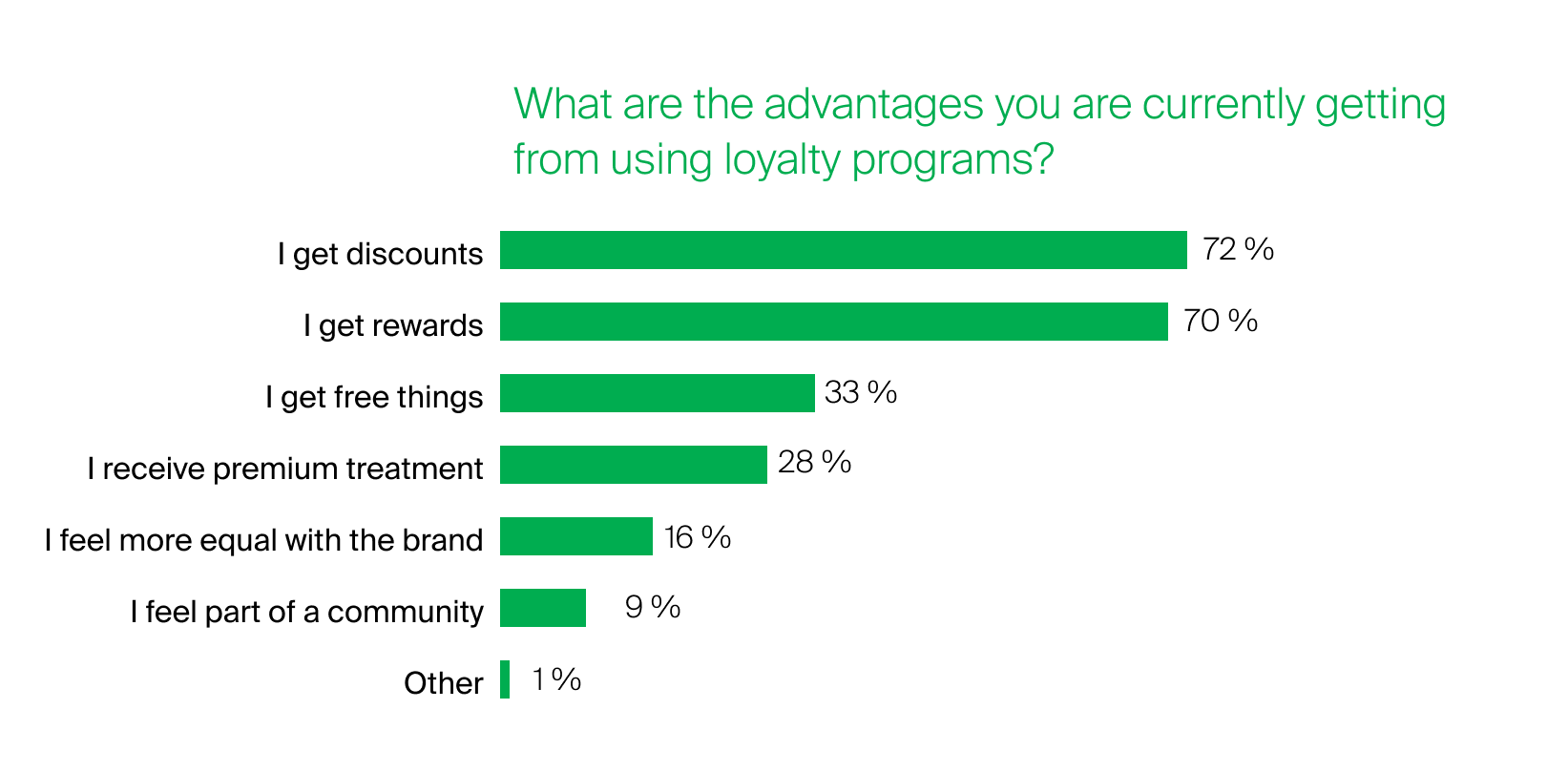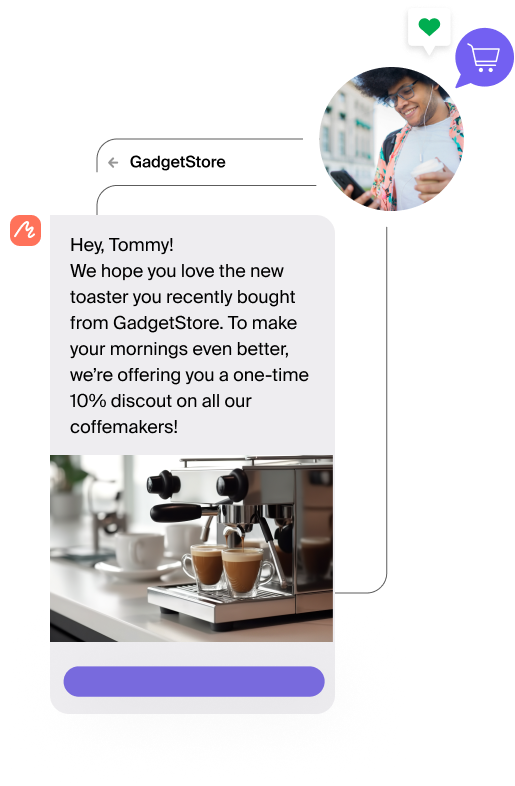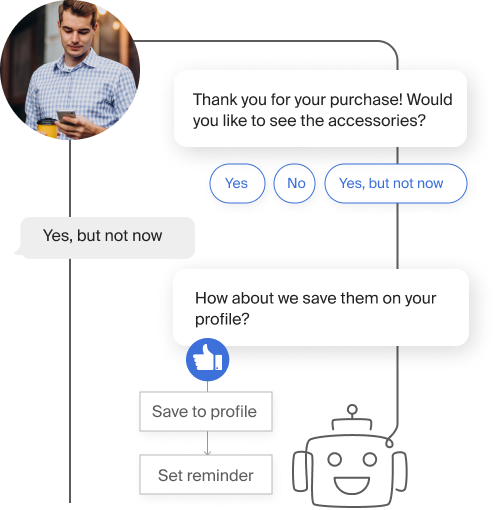When an average U.S. consumer belongs to 16.6 loyalty programs and actively uses only 7.6, brands can have a tough time getting to the top of this list. Things are not much different in the UK, where 81% of survey respondents said they belong to a loyalty program (with 91% of them using more than one).
Yet, even when a consumer joins a brand’s loyalty programme, does this mean they have a deep emotional connection to the brand? Research says no.
72% of respondents in the Software Advice survey quote “discounts” as the primary advantage of loyalty memberships, while 70% join such programs for “rewards”. Only 16% do it because they “feel more equal with the brand” and 9% because they “feel themselves a part of a community”.

While customer loyalty programs certainly help brands create positive customer experiences and increase sales, they’re not essential to building loyalty. In this article, we’ll review the foundations of this concept and provide tips for brands on how to foster it.
The value (vs. price) of brand loyalty
To deepen customer relationships and build meaningful connections, brands need to provide authentic experiences across all touchpoints. A big part of that is delivering distinctive value not only in terms of price, but also by evoking positive sentiments through communications, purchase processes and support interactions.
Some of the most commonly quoted elements of brand loyalty include:
- Perceived value – the overall experience with a product/service. If a customer feels their expectations have been met or exceeded, they’ll have a higher perceived value of the brand.
- Perceived quality – a consumer’s sense that a product/service helped them achieve their goal or meet a specific need while being easy to use and available at a reasonable price.
- Customer satisfaction – a highly subjective criterion for measuring how happy does the customer feel using the product/solution and interacting with brand representatives.
- Brand image – a mix of impressions and emotions about a brand after trying one or more of its products/solutions.
By including all the above elements in their loyalty building strategies, brands can achieve long-term results which are best reflected in customer satisfaction scores and increased profitability. Now, let’s take a look at the practical steps for achieving this.
STEP 1: Build familiarity with your audience – both ways.

Given that consumer buying behaviours tend to change fast and often in unpredictable ways, brands need to consistently analyse their consumers’ habits, preferences, and desires. By using behavioural analytics, they can create personalised products, services, and marketing messages that resonate with their customers, leading to higher satisfaction, improved loyalty, and faster business growth.
In the past, companies often relied on standard audience segmentation models that grouped customers based on static characteristics like age, gender, income level, and location. However, these models are no longer sufficient due to shifting consumer habits and buying behaviours. Several factors are contributing to this change include:
- Digital Transformation: the rise of e-commerce has led to increased competition and the need for retailers to offer a seamless online shopping experience.
- Changing Lifestyles and Values: consumers increasingly see out environmentally friendly products and companies, often doing their research on the go using mobile devices.
- Personalisation and Customisation: Companies are moving from broad customer segments to personalised profiles, as consumers expect experiences tailored to their needs and preferences.
- Increased Consumer Empowerment: with the rise of social media and review sites, consumers have gained more power to influence brands and share their opinions with others.
STEP 2: Be where your customers need you.
The old adage “out of sight, out of mind” holds true in the business world. Neglecting to engage with consumers in the places they frequent, whether it’s offline or online, can reduce visibility of your products or services. Communication channels are especially important to consider. People have different preferences regarding communication, which is why it is vital to establish two-way customer communication across various platforms, including SMS, messaging apps like Viber and WhatsApp, as well as AI chatbots.
SMS
SMS messaging has a 100% view rate and 55% read rate, making, making it an incredibly effective way of reaching customers. It’s a personal and direct means of communication that can be accessed by almost anyone with a mobile phone. Additionally, it’s asynchronous, allowing customers to reply at their convenience.
Viber and WhatsApp
Using messaging apps is an excellent way of connecting with customers who prefer this mode of communication. These apps offer various features, such as voice and video calls, group chats, and multimedia messaging, providing you with multiple options for interacting with your customers.
AI Chatbots
Conversational AI offers an efficient way to address customer inquiries, answer frequently asked questions, and gather valuable customer data on their requirements and behaviours. They are available round the clock, providing 24/7 customer service and allowing human staff to focus on resolving complex issues.

STEP 3: Keep a constant vigil to inspire trust.
With digital commerce becoming a new norm, customer expectations have evolved drastically. Today’s consumers expect immediate responses and constant availability from businesses, regardless of the time zone or hour of the day. Earlier research by HubSpot revealed that 82% of consumers rate “immediate” responses as important or very important when they have a marketing or sales question, while 90% confirmed this for support questions.
This is particularly important in an era where online shopping has become the rule, and competition is fierce. Constant availability helps brands ensure improved customer satisfaction by quickly resolving support issues through SMS or AI Chatbots. Additionally, this helps increase sales as customers often need quick assistance while making purchase decisions. By consistently providing support and instant responses, brands also build loyalty, increase customer retention, and encourages repeat business. This also helps improve crisis management, as brands can deliver immediate responses to mitigate any negative impacts of an unpredicted crisis situation.
AI Chatbots are particularly useful for ensuring immediate availability as they can manage unlimited number of chats 24/7. They can also seamlessly transfer to live agents in case of sensitive or urgent matters, which is one of the reasons conversational AI is increasingly trusted by consumers.
STEP 4: Help customer overcome their fatigue.
The idea of clients getting emotionally drained by the constant onslaught of blunt advertising has been around for at least two decades now. And since the number of products and communication channels grows exponentially, tailoring communications and promotions based on a customer’s unique needs, preferences, and behaviours becomes necessary for increasing brand loyalty and boosting revenues.
Additionally, generating personalised offers and utilising dynamic content can help enhance their experience. Here are the strategies that will help you brighten up your consumers’ journey and help them make a decision while providing an enjoyable brand experience:
- Leverage Interactive Content: polls, quizzes, surveys, games, and interactive videos can help to engage customers more effectively
- Implement Loyalty Programs: rewarding customers for their loyalty can motivate them to engage more with your brand
- Engage via Social Media: sharing user-generated content, responding to comments, and organising contests can improve engagement
- Personalise Your Communication: tailoring messages to a customer’s preferences and interests can help them feel more connected to your brand
- Build Omnichannel Experiences: provide a seamless experience across all channels, from physical stores to online platforms and messaging apps
STEP 5: Stay in touch post purchase.

Customer surveys or polls are a powerful tool for gathering feedback, understanding customer preferences, and improving products or services. There are several ways businesses can gather feedback from customers, including SMS surveys, chatbots, email surveys, social media polls, website surveys, and messaging apps.
SMS surveys have a high open rate and can be sent through an SMS gateway or integrated with a customer relationship management system. AI Chatbots, on the other hand, can be programmed to ask questions in a conversational manner on websites and social media platforms. Messenger apps like Viber and Facebook Messenger can also be very convenient for collecting feedback, as they cater to clients.
When creating surveys, use clear language, keep it short, explain the purpose, and act on the feedback while respecting privacy laws and obtaining proper consent. The data collected this way helps you further improve customer experiences in future while the very fact you’re asking for their opinion is another way to validate it and show you care.
STEP 6: Reward loyalty with practical perks.
Offering rewards and discounts to repeat customers provides numerous benefits to both sides, especially considering consumer demand as discussed in the intro. By providing a loyalty program, brands can achieve the following benefits:
- Customer Retention: Discounts and incentives can strongly encourage customers to keep doing business with your brand. This can drive revenue increase as it is usually more cost-effective to keep existing customers than it is to acquire new ones.
- Increased Sales: Loyalty programs incentivise customers to make more frequent purchases or spend more money each time they shop to earn rewards or discounts.
- Customer Engagement: Providing rewards or discounts can motivate customers to make frequent visits to the website or physical store and increase engagement on social media or other marketing channels.
- Valuable Customer Data: Through loyalty programs, businesses can gain valuable data about their customers’ purchasing habits. This can be used to personalise the shopping experience, make more effective marketing decisions, or develop new products or services that better meet customers’ needs.
- Brand Advocacy: Customers who are part of a loyalty program and receive benefits like discounts are more likely to recommend the business to others. They may also leave positive reviews, which can attract more customers and enhance the brand’s reputation.
- Predictable Revenue Stream: Loyal customers with a routine or pattern of buying from your business can lead to more predictable sales and revenue. This can help with planning and forecasting for the business.
Remember, it is crucial for the discounts and rewards to be meaningful and relevant to your customers to effectively gain these benefits. Otherwise, the program might not be as effective as you hope.
What’s next?
To win customers in the digital commerce landscape, businesses need to prioritise customer-centric strategies that involve understanding and respecting their needs while delivering a consistent brand experience across a wide array of channels, such as SMS, Viber and AI chatbots. Personalisation is crucial to establishing genuine connections with consumers, tailoring communications and loyalty programs, as well as retaining existing customers via meaningful journeys.
If you are looking to enhance the communication aspects of your customer engagement strategy, make sure to contact GMS experts today!


